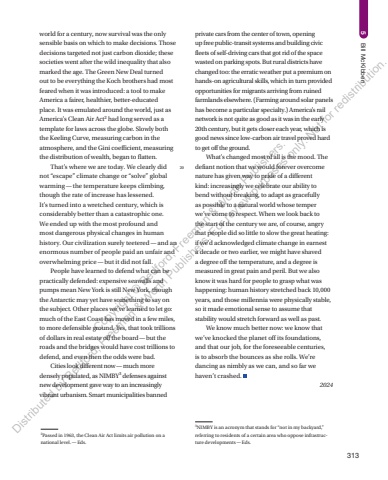Page 225 - Demo
P. 225
313world for a century, now survival was the only sensible basis on which to make decisions. Those decisions targeted not just carbon dioxide; these societies went after the wild inequality that also marked the age. The Green New Deal turned out to be everything the Koch brothers had most feared when it was introduced: a tool to make America a fairer, healthier, better-educated place. It was emulated around the world, just as America%u2019s Clean Air Act2 had long served as a template for laws across the globe. Slowly both the Keeling Curve, measuring carbon in the atmosphere, and the Gini coefficient, measuring the distribution of wealth, began to flatten.That%u2019s where we are today. We clearly did not %u201cescape%u201d climate change or %u201csolve%u201d global warming%u2014the temperature keeps climbing, though the rate of increase has lessened. It%u2019s turned into a wretched century, which is considerably better than a catastrophic one. We ended up with the most profound and most dangerous physical changes in human history. Our civilization surely teetered%u2014and an enormous number of people paid an unfair and overwhelming price%u2014but it did not fall.People have learned to defend what can be practically defended: expensive seawalls and pumps mean New York is still New York, though the Antarctic may yet have something to say on the subject. Other places we%u2019ve learned to let go: much of the East Coast has moved in a few miles, to more defensible ground. Yes, that took trillions of dollars in real estate off the board%u2014but the roads and the bridges would have cost trillions to defend, and even then the odds were bad.Cities look different now%u2014much more densely populated, as NIMBY3 defenses against new development gave way to an increasingly vibrant urbanism. Smart municipalities banned 20private cars from the center of town, opening up free public-transit systems and building civic fleets of self-driving cars that got rid of the space wasted on parking spots. But rural districts have changed too: the erratic weather put a premium on hands-on agricultural skills, which in turn provided opportunities for migrants arriving from ruined farmlands elsewhere. (Farming around solar panels has become a particular specialty.) America%u2019s rail network is not quite as good as it was in the early 20th century, but it gets closer each year, which is good news since low-carbon air travel proved hard to get off the ground.What%u2019s changed most of all is the mood. The defiant notion that we would forever overcome nature has given way to pride of a different kind: increasingly we celebrate our ability to bend without breaking, to adapt as gracefully as possible to a natural world whose temper we%u2019ve come to respect. When we look back to the start of the century we are, of course, angry that people did so little to slow the great heating: if we%u2019d acknowledged climate change in earnest a decade or two earlier, we might have shaved a degree off the temperature, and a degree is measured in great pain and peril. But we also know it was hard for people to grasp what was happening: human history stretched back 10,000 years, and those millennia were physically stable, so it made emotional sense to assume that stability would stretch forward as well as past.We know much better no we know that we%u2019ve knocked the planet off its foundations, and that our job, for the foreseeable centuries, is to absorb the bounces as she rolls. We%u2019re dancing as nimbly as we can, and so far we haven%u2019t crashed. 20242Passed in 1963, the Clean Air Act limits air pollution on a national level.%u2014Eds.3NIMBY is an acronym that stands for %u201cnot in my backyard,%u201d referring to residents of a certain area who oppose infrastructure developments%u2014Eds.5 Bill McKibbenCopyright %u00a9 Bedford, Freeman & Worth Publishers. Distributed by Bedford, Freeman & Worth Publishers. For review purposes only. Not for redistribution.


